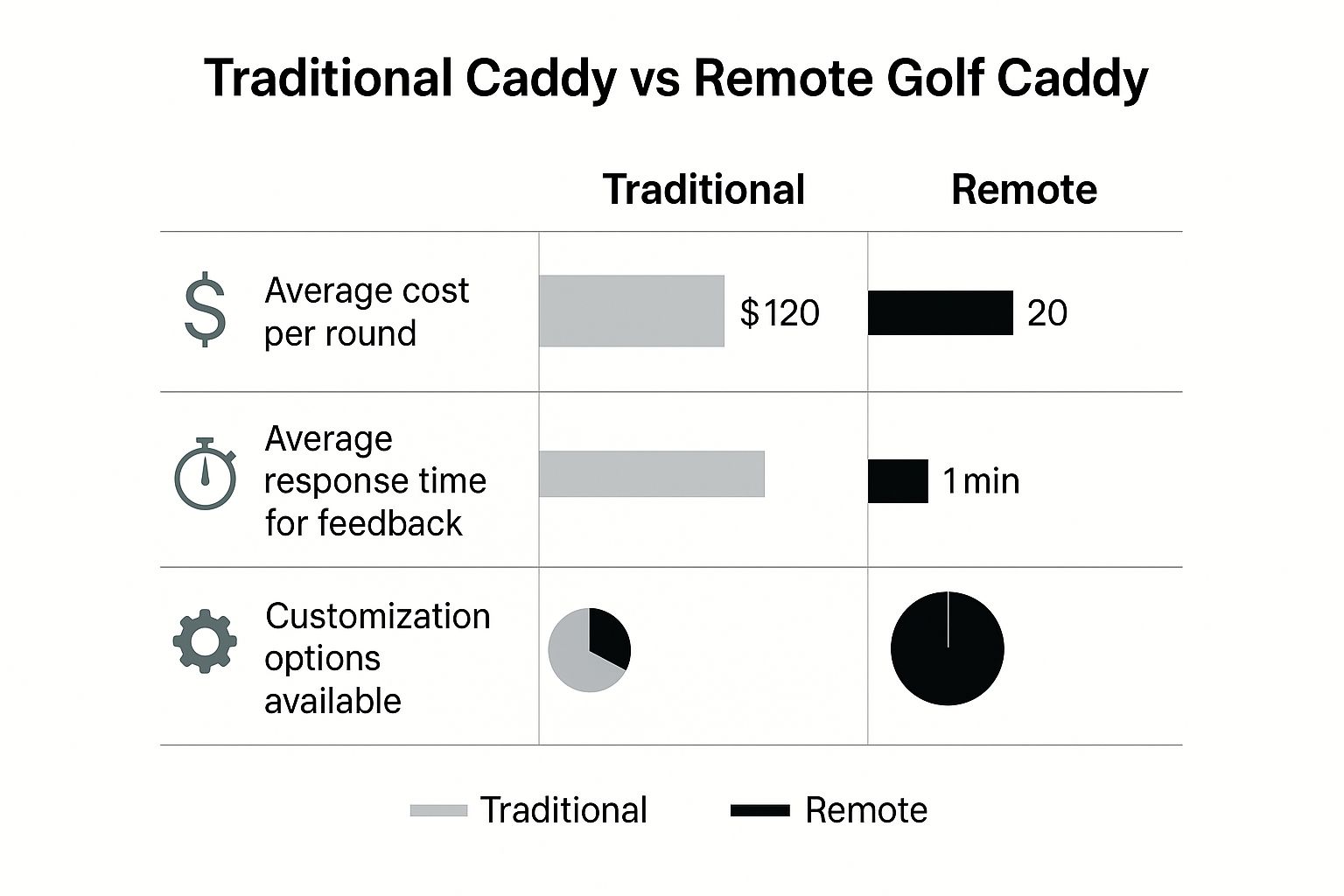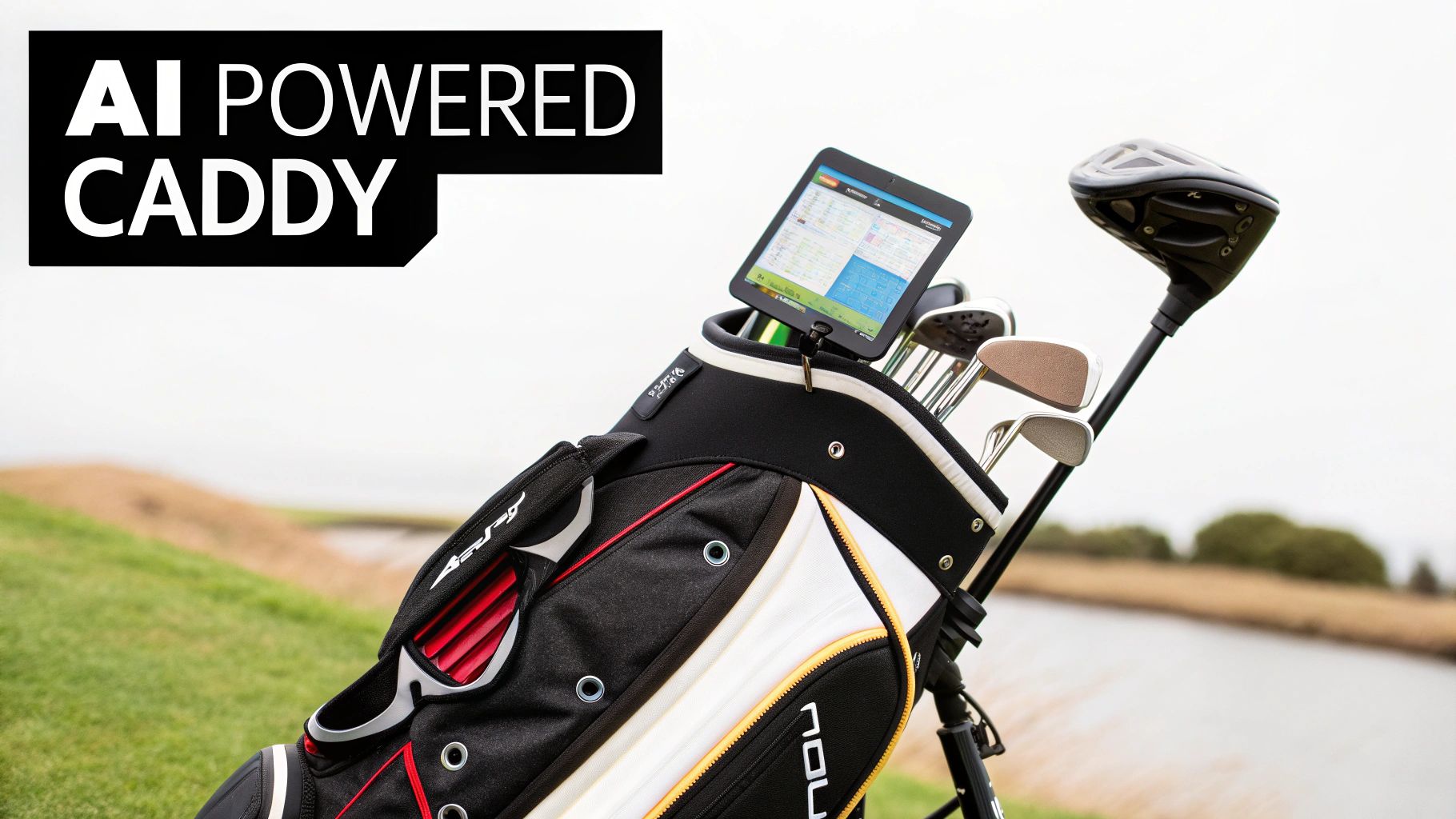At its heart, a remote golf caddy is a motorized push cart you control with a handheld remote. It lets your clubs tag along behind you or sends them ahead to the next tee, all on their own. This simple but brilliant tech frees you from the grunt work of pushing or carrying your bag, so you can just walk the course and focus on your game.
What Is A Remote Golf Caddy And Is It Worth It?
Imagine strolling down the fairway, completely dialed in on your next shot, while your clubs quietly follow a few paces behind like a loyal, robotic assistant. That’s the experience a remote golf caddy delivers. It's more than just a gadget; it's about fundamentally changing how you interact with the course.
Think of it like this: a regular push cart is like a manual lawnmower. You're doing all the work. A remote caddy, on the other hand, is like one of those robot vacuums—you point it in the right direction, and it handles the rest, freeing you up for more important things. That shift from manual labor to remote operation is where the real magic happens.
Unpacking The Core Value
The benefits here go way beyond simple convenience. When you offload the physical chore of wrestling a heavy golf bag across 18 holes, you gain some serious advantages that can directly improve your score and how much fun you have.
These include:
- Less Physical Strain: Walking 18 holes is fantastic exercise, but lugging a 30-pound bag and cart up and down hills is just draining. A remote caddy wipes that fatigue off the map, saving your strength for your swing, especially on the back nine.
- Sharper Mental Focus: Instead of constantly figuring out the easiest path to push your cart, you can dedicate all that mental energy to course management, shot selection, and reading the greens. That mental clarity is a massive competitive edge.
- A More Enjoyable Round: The freedom to walk unburdened just makes the game more pleasant. You can chat with your partners, take in the scenery, and simply enjoy the walk from the first tee to the last.
This chart breaks down the key differences between a human caddy and a remote one.

While nothing can fully replace the instant feedback of a traditional caddy, the data shows that a remote caddy offers a practical, highly cost-effective alternative for the everyday golfer.
To better understand where remote caddies fit in, let's compare them to the other common options for getting your clubs around the course.
Comparing Your Golf Caddy Options
The table below gives you a quick, high-level look at how manual push carts, standard electric trolleys, and remote caddies stack up. Each one serves a different purpose and appeals to a different type of golfer.
| Caddy Type | How It Moves | Primary Benefit | Best For The Golfer Who... |
|---|---|---|---|
| Manual Push Cart | You push it | Low cost and simplicity | Wants the exercise of walking and pushing, and prefers a no-frills, budget-friendly option. |
| Electric Trolley | You guide it with a handle | Eliminates pushing effort | Wants to walk without the strain of pushing but still likes to have hands-on control of their cart. |
| Remote Golf Caddy | You direct it with a remote | Complete hands-free freedom | Wants to walk completely unburdened to conserve energy and maintain total focus on their game. |
Seeing them side-by-side makes it clear: the remote caddy is all about maximizing freedom and minimizing physical effort, taking the walking experience to a whole new level.
A Growing Part of The Game
This technology isn't just a niche gadget anymore; it's becoming a mainstream part of the golf world. The market for electric and remote-controlled trolleys was valued at USD 147 million in 2024, fueled by golfers demanding features like precise speed control and automatic braking on hills. This trend is only getting stronger, with the market expected to climb to nearly USD 228 million by 2032. You can read more about this market growth on MaximizeMarketResearch.com.
The core appeal is simple: A remote golf caddy lets you get the health benefits of walking the course without the performance-draining fatigue of carrying or pushing your bag.
So, is a remote caddy "worth it"? It all comes down to what you want out of your round. If you're looking to save energy, sharpen your focus, and simply have a better time on the course, the investment can pay for itself in just a few rounds.
To dive into specific models and find the right fit, you should check out our guide to the best remote control golf trolleys for more detailed reviews.
What's Under the Hood? The Tech Inside a Modern Remote Caddy

A modern remote caddy can feel like pure magic as it glides across the fairway, but it's really a clever combination of proven technologies working together. To truly get why these machines are so valuable, it helps to peek under the hood and see what makes them tick. At its heart, the whole system is built on a seamless wireless link between the handheld remote and the caddy's onboard motor.
This connection lets you steer, change speed, and hit the brakes from up to 50-100 yards away. It’s not just about going forward and backward; it’s about having responsive, intuitive control that lets you send your bag exactly where you want it. This kind of smart navigation is a huge reason the global golf trolley market was valued at USD 14.6 billion in 2024, with its popularity exploding in Europe and North America. You can dig into more of the market data over at IMARC Group.
Follow Mode and Advanced Navigation
One of the coolest innovations you'll find on high-end models is Follow Mode. Picture this: your caddy becomes your own personal shadow, trailing you down the fairway without you ever touching the remote. It uses a mix of ultrasound, Bluetooth, or GPS sensors to lock onto the remote’s signal and keep a steady distance from you as you walk. Just clip the remote to your belt, and off you go.
This completely hands-free operation is a massive advantage. It frees you up to think about your next shot, chat with your partners, or just enjoy the walk. While the tech behind it is pretty complex, the goal is to make the experience feel effortless and natural. If you want to dive deeper into the different types of trolleys, our modern golfer's remote golf push cart guide is a great place to start.
Battery Power and On-Course Stability
The real workhorse of any remote caddy is its battery. While older carts used to lug around heavy sealed lead-acid (SLA) batteries, today's best units run on lightweight and powerful lithium-ion batteries. These are absolutely critical for top-tier performance.
- Longevity: A good lithium battery will easily get you through 18 holes, and many premium models can even handle a full 36 holes on a single charge.
- Weight: Lithium batteries are way lighter than their old-school counterparts. This makes the caddy more balanced on the course and a lot easier to lift into your car.
- Lifespan: They also last much longer, giving you hundreds of charge cycles over several years if you take care of them.
A remote caddy is only as good as its stability. A powerful motor and a great battery mean nothing if the cart is constantly at risk of tipping over on uneven ground.
Manufacturers have gotten smart about this. A low center of gravity is key to keeping the caddy planted, especially on side-hill lies. Many models also feature a small anti-tip wheel at the back for extra security on steep climbs. The wheels themselves are another crucial piece of the puzzle, with specialized treads designed to grip wet grass and navigate rough terrain without spinning out. All these elements work together to give you the confidence to send your caddy just about anywhere on the course.
The Real On-Course Benefits of Walking Unburdened
 Sure, a remote caddy is convenient, but the real magic happens in how it quietly improves your game. It’s about more than just not having to push a cart. When you walk the course completely unburdened, something shifts—both physically and mentally. The result? A better score and a much better time.
Sure, a remote caddy is convenient, but the real magic happens in how it quietly improves your game. It’s about more than just not having to push a cart. When you walk the course completely unburdened, something shifts—both physically and mentally. The result? A better score and a much better time.
Picture this: it’s a hot summer day on a hilly course. Every single slope feels like a mountain when you’re wrestling a 30-pound push cart. By the time you hit the back nine, you're wiped out. Your swing gets sloppy, your focus drifts, and good shots become a distant memory.
Now, imagine that same round, but with a remote caddy doing all the work. You stroll up to your ball on every hole feeling fresh, clear-headed, and ready to play your best golf. That’s the difference we’re talking about.
Conserve Physical Energy for Your Swing
Walking 18 holes is fantastic exercise, and it can burn over 700 calories. But lugging or pushing a heavy bag piles on extra strain, especially on your back, shoulders, and legs. That exhaustion doesn't just make you tired; it directly steals power and consistency from your swing.
A remote golf caddy takes that physical tax right out of the equation. You get all the health perks of walking without the performance-killing fatigue. This saved energy shows up where it counts:
- A Stronger Finish: You’ll have more gas in the tank for those make-or-break shots on the back nine, helping you dodge the dreaded late-round collapse.
- Reduced Injury Risk: Taking the weight off your body means less stress on your joints and muscles. You’ll walk off the 18th green feeling good, not beat up.
- Better Swing Mechanics: When you aren't fighting physical fatigue, you can maintain a stable, powerful, and repeatable swing from the first tee to the final putt.
Sharpen Your Mental Game
The advantages go way beyond the physical. When you’re not constantly searching for the smoothest path for your cart or dragging it around bunkers, your mind is freed up to focus purely on strategy and hitting your shot.
A clear mind is a golfer's greatest asset. By removing the physical distraction of managing your bag, a remote caddy lets you dedicate 100% of your mental bandwidth to playing your best golf.
This newfound mental clarity leads directly to smarter course management. You can walk ahead to scout your next landing zone, check out the green's contours from different angles, and chat about club selection with your partners—all while your bag trails you like a loyal companion.
This freedom completely changes your approach. You’re no longer just moving from shot to shot; you’re thinking several moves ahead, turning a simple walk into a genuine competitive edge.
How to Choose the Right Remote Caddy for Your Game
So, you’re ready to pull the trigger and invest in a remote caddy. That's a great move for your game. But choosing the right one isn't about grabbing the shiniest model off the shelf—it's about finding the perfect match for you, your course, and how you play.
Think of it like buying a new driver. You wouldn't just pick one at random. You'd think about your swing speed, your typical miss, and the ball flight you're after. Picking a remote golf caddy requires that same thoughtful approach. Let's walk through how to find the one that will feel like a true partner every time you step up to the first tee.
Assess Your Home Course and Playing Style
First things first, let’s look at your home turf. The remote caddy that glides beautifully across a flat, manicured resort course might completely give up the ghost on a rugged, hilly monster.
You need to be honest about a few things:
- Terrain: Do you spend your days on flat fairways, or are you constantly grinding up steep hills and navigating uneven lies? For hilly tracks, a model with automatic downhill braking and a low center of gravity isn't just a nice-to-have; it's essential for keeping your cart (and your expensive clubs) from taking a tumble.
- Battery Needs: Are you strictly an 18-hole player, or do you live for those 36-hole marathons? A standard lithium battery will handle 18 holes just fine. But if you're the type to play from sunup to sundown, you absolutely need an extended-range battery.
Getting clear on these two points will immediately shrink your list of options. It ensures you don't overpay for features you’ll never touch or, even worse, end up with a cart that simply can't hang.
Practicality Portability and Storage
A remote caddy is a dream on the course, but remember, you have to get it there and back. This is where practicality comes in, a factor many golfers don't think about until they're wrestling with a bulky unit in the club parking lot.
Before you make a final call, ask yourself some simple, practical questions. How easily does it fold? The best ones are intuitive, collapsing into a surprisingly small package in just a few moves. Get out a tape measure and check your trunk space to make sure it’ll fit comfortably next to your bag. A lightweight frame also makes a world of difference when you're lifting it in and out of your car after a long round.
Your remote caddy should simplify your golf life, not complicate it. A model that is heavy, bulky, or difficult to fold will quickly become a source of frustration, undermining the very convenience you’re paying for.
Comparing Caddies by Budget
Your budget will obviously play a huge role, but it helps to know what your money gets you at different levels. As the price tag goes up, you're not just paying for a brand name; you're buying more sophisticated features, tougher materials, and smoother performance.
To help make sense of it all, here's a look at what you can expect in the entry-level, mid-range, and premium tiers.
Remote Caddy Features by Budget
| Price Tier | Expected Features | Typical Battery | Best For |
|---|---|---|---|
| Entry-Level | Basic remote controls (forward, left, right), manual speed dial, and a simple frame. | Sealed Lead-Acid (SLA) or a basic Lithium. Built for 18 holes. | Golfers on mostly flat courses who want the core remote experience on a tight budget. |
| Mid-Range | Downhill braking, a more stable chassis, maybe a USB port, and a more responsive remote. | Standard Lithium. Usually rated for 18-27 holes. | The average golfer who plays on varied terrain and wants a reliable, feature-rich unit that will last. |
| Premium | "Follow Me" mode, gyroscope for straight tracking, ultra-lightweight frame, extended-life battery. | High-capacity Lithium. Often rated for 36+ holes. | The serious golfer who plays often, demands flawless performance on any terrain, and wants the latest tech. |
At the end of the day, the best caddy isn't the most expensive one—it's the one that feels like a natural extension of your game. By thinking through your course, your habits, and your budget, you can make a smart choice that will pay you back with more enjoyable, less strenuous rounds for years to come.
Is This Golf Tech a Trend or Here to Stay?

Investing in new golf equipment always feels like a bit of a gamble, doesn't it? We've all wondered if that flashy new driver is really a game-changer or just clever marketing. The same question naturally pops up with a remote golf caddy. Is this just another gadget that will collect dust in the garage, or is it a genuine, long-term shift in how we play the game?
All the signs, however, point overwhelmingly toward this technology becoming a permanent part of the golf landscape. This isn't just a gimmick; it's a response to powerful forces shaping the future of golf.
More Than Just a Fad
The explosive growth of remote caddies is being fueled by a perfect storm of factors. First, the golfing population is getting older, and players are looking for smart ways to stay in the game longer while reducing physical strain. A remote caddy is the perfect answer, letting them get all the health benefits of walking the course without the back-breaking work of hauling a bag.
Second, there’s a growing focus on wellness and smart fitness in the sport. Golfers are savvier than ever, understanding that conserving energy on the course directly translates to better focus, stronger swings, and lower scores. Handing your bag over to a robotic assistant is simply a smart strategic move.
Finally, the tech itself has become incredibly reliable and easy to use. Big leaps in lithium-ion batteries, responsive remote controls, and sophisticated guidance systems have turned these caddies into powerful and dependable partners on the course.
This isn't just a cool toy for the first person on the block to have one. The remote golf caddy is a practical solution that meets the real-world needs of a massive and passionate golfing community.
The market numbers tell the same story. The global market for remote-control electric golf caddies was pegged at around USD 165 million in 2024. Industry analysts expect it to climb to roughly USD 241 million by 2031, showing a strong and steady growth rate. You can discover more insights about remote caddy market growth in detailed industry reports. That's not the sign of a fad; it's a market finding its footing for the long haul.
When you invest in a remote caddy, you’re buying into a product category with a bright future—one that will see continuous innovation and support for years. It’s a solid choice for any player looking to improve their game. For those curious about a more affordable entry point, it's also worth asking, "Why every golfer should switch to an electric golf cart push system," as they offer many of the same energy-saving benefits.
Still Have Questions? Let's Clear Things Up
Even after seeing all the benefits, it's totally normal to have a few practical questions before you decide to buy a remote caddie. The technology sounds impressive, but how does it really perform out there on the course—with its bad lies, sudden downpours, and tricky layouts?
We've pulled together the most common questions golfers have right before they pull the trigger. Our goal is to tackle those "what if" moments head-on, giving you the last few bits of info you need to feel confident in your choice. Think of this as the final chat you'd have with a buddy before teeing off with your new robotic partner.
How Do These Things Handle Tough Courses?
This is a big one. What happens when your caddie meets a monster hill, thick rough, or slick, wet grass? Are you going to be chasing it down a fairway or watching it tip over?
Don't worry, modern remote caddies are built for exactly these scenarios, not just for perfectly flat, manicured fairways. The good ones are packed with smart engineering.
- Automatic Downhill Braking: This is a non-negotiable feature for hilly courses. It automatically slows the caddie on steep declines, so it never gets away from you. It maintains a safe, controlled pace all on its own.
- Specialized Wheel Treads: Just like tires on a car, the tread on a caddie's wheels makes a huge difference. You want models with deep, aggressive treads that bite into wet turf to prevent slipping and sliding.
- Low Center of Gravity: A smart design keeps the weight of your bag and the battery as low to the ground as possible. This makes the caddie incredibly stable, especially on those awkward sidehill lies, and dramatically cuts down the risk of it tipping over.
A quality remote caddie gives you the confidence to send it across terrain you wouldn't even want to push a manual cart through.
What's the Real-World Battery Life?
Battery anxiety is a real thing. Nobody wants their caddie to die on the 15th hole, leaving them to lug a heavy, dead unit for the rest of the round.
Fortunately, battery tech has improved by leaps and bounds. The vast majority of remote caddies now run on dependable lithium-ion batteries. Here’s what you can actually expect:
- 18-Hole Standard: Nearly every model will comfortably last a full 18 holes. That's even on a tough, hilly course that makes the motor work harder.
- 36-Hole Option: Many of the top-tier models offer an extended-life battery that can go for a full 36 holes on a single charge. This is perfect for the golfer who loves to play from sunup to sundown.
- Charge Time: A full charge usually takes somewhere between 4 to 8 hours. The best habit to get into is plugging it in as soon as you get home from a round. That way, it's always ready for your next tee time.
A quick pro tip: to get the most life out of your battery, try to avoid storing it in extreme temperatures (like a scorching hot car trunk) and always stick to the manufacturer's charging instructions.
Think of your caddy's remote like a TV remote—it’s designed for simplicity. While the technology behind it is advanced, the user experience is intentionally straightforward and intuitive.
Are They a Pain to Use on The Course?
It's a fair question. The whole point is to make your round easier, not add another complicated gadget to fuss with.
Manufacturers have poured a ton of effort into making these things incredibly user-friendly. The initial setup is usually a one-time deal of just unfolding the frame and pairing the remote. Once you're on the course, you'll find the basic steering and speed controls are so intuitive you'll have them down in the first couple of holes.
Sure, some of the more advanced features like "Follow Mode" might take a little getting used to, but you'll be navigating it like a pro by the end of your first round. They're designed to feel like a natural extension of your game, not a distraction.
What If The Remote Dies or Fails?
This might be the most important "what if" of all. What happens if you drop the remote and it breaks, the battery dies unexpectedly, or you lose the connection?
Every single reputable remote caddie is built with critical fail-safes to prevent a runaway disaster.
- Automatic Stop: If the caddie ever loses the signal from the remote, its default command is to stop immediately. There is zero risk of it taking off on its own and driving into a water hazard.
- Manual Mode: Pretty much all models can be switched into a free-wheel or manual push mode in seconds. In the very unlikely event of a total remote failure, you just disengage the motors and push it like a normal push cart. You will never be left stranded.
These safety features guarantee that no matter what happens, you and your expensive gear will always be safe, and you'll always be able to finish your round.
Ready to stop pushing and start playing? The Caddie Wheel offers a simple, powerful, and affordable way to motorize your existing push cart. Experience the freedom of walking unburdened and save your energy for the game. Learn more and elevate your round at https://caddiewheel.com.


Share:
The Modern Golfer's Remote Golf Push Cart Guide
7 Best Places to Buy 3 Wheel Electric Golf Carts in 2025